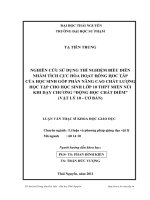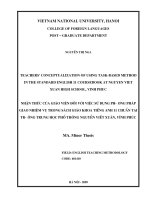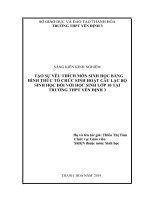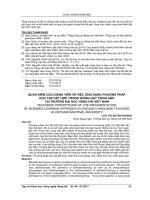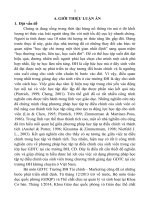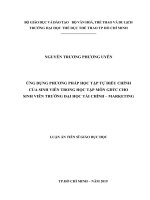Ứng dụng phương pháp học tập theo nhiệm vụ trong sách giáo khoa cho học sinh lớp 10
Bạn đang xem bản rút gọn của tài liệu. Xem và tải ngay bản đầy đủ của tài liệu tại đây (1023.04 KB, 69 trang )
VIETNAM NATIONAL UNIVERSITY, HANOI
UNIVERSITY OF LANGUAGES & INTERNATIONAL STUDIES
FACULTY OF POST – GRADUATE STUDIES
*********
TRẦN THỊ MAI HUYỀN
APPLICATIONS OF TASK-BASED LANGUAGE APPROACH IN
TEXTBOOKS FOR GRADE-10 STUDENTS IN DEVELOPING
LISTENING SKILLS: AN ACTION RESEARCH
(ỨNG DỤNG PHƯƠNG PHÁP HỌC TẬP THEO NHIỆM VỤ TRONG
SÁCH GIÁO KHOA CHO HỌC SINH LỚP 10 NHẰM PHÁT TRIỂN
KĨ NĂNG NGHE: MỘT NGHIÊN CỨU HÀNH ĐỘNG)
M.A MINOR PROGRAMME THESIS
Field: English Teaching Methodology
Code: 8140231.01
HANOI – 2020
VIETNAM NATIONAL UNIVERSITY, HANOI
UNIVERSITY OF LANGUAGES & INTERNATIONAL STUDIES
FACULTY OF POST – GRADUATE STUDIES
*********
TRẦN THỊ MAI HUYỀN
APPLICATIONS OF TASK-BASED LANGUAGE APPROACH IN
TEXTBOOKS FOR GRADE-10 STUDENTS IN DEVELOPING
LISTENING SKILLS: AN ACTION RESEARCH
(ỨNG DỤNG PHƯƠNG PHÁP HỌC TẬP THEO NHIỆM VỤ TRONG
SÁCH GIÁO KHOA CHO HỌC SINH LỚP 10 NHẰM PHÁT TRIỂN
KĨ NĂNG NGHE: MỘT NGHIÊN CỨU HÀNH ĐỘNG)
M.A. MINOR PROGRAMME THESIS
Field: English Language Teaching Methodology
Code: 8140231.01
Supervisor: Prof. Dr. Hoàng Văn Vân
HANOI – 2020
DECLARATION
I guarantee that I myself write this thesis entitled “Applications of Task-based
language approach in textbooks for grade-10 students in developing listening
skills”. There is no plagiarism here and if anything is taken from others’ works, it is
surely written in quotation. Then, the sources would be listed on the list of
references. I am ready to be inflicted any academic punishment if the proclamation
proves inaccurate.
Signature
Tran Thi Mai Huyen
i
ACKNOWLEDGEMENTS
Firstly, I would like to express my gratitude to my thesis advisor, Prof. Dr.
Hoang Van Van for his continuous support, invaluable feedback throughout the
process of the study. He provided me with constant guidance and encouragement
which turned the demanding thesis writing into a smooth and fruitful process.
I would also like to express my special thanks to all my dear colleagues of
FPT High School, and my classmates of the Department of Post-graduate Studies,
University of Languages and International Studies, Vietnam National University,
Hanoi who never hesitated to help me and share their experience.
Special thanks to all participants in FPT High School for their participation
and patience during the process of the study in the academic year of 2018- 2019
semester.
Finally, I am deeply grateful to all members of my family for being so
motivating and patient throughout the study.
ii
ABSTRACT
Developing listening skills is an important sphere in studying a language. This
study focused on improving listening skills through Task-based language teaching
(TBLT). TBLT is a methodology that develops from a focus on classroom tasks. 30
grade-10 students in FPT High School were the participants of the study through an
action research with two cycles of treatment employed. A pre-test, the instruction,
and two post-tests were given to the participants. TBLT was applied for the
participants. The comparisons between the results of the pre-test and post-tests were
made through paired sample t-tests. The results indicated that the students after the
treatment performed better. The results were also supported by the data collected
from interviews, questionnaires and class observations. This study may have
pedagogical implications for practitioners in the field and for syllabus designers to
have suitable tasks in English textbooks and English teachers would use the most
effective teaching methods for their students.
iii
LISTS OF ABBREVIATIONS
EFL: English as Foreign Language
Ss: Students
T: Teacher
TBLT: Task-based language teaching
MOET: The Vietnamese Ministry of Education and Training
CEFR: The Common European Framework of Reference for Languages
iv
LISTS OF TABLES AND FIGURES
Table 3.1: Score interval for tests .............................................................................23
Table 4.1: Kinds of tasks in while-listening stage ....................................................29
Table 4.2: Paired Samples Statistics (pre-test & post-test 1) ....................................32
Table 4.3: Paired Samples Correlations (pre-test & post-test 1) ..............................33
Table 4.4: Paired Samples Statistics (post-test 1 & post-test 2) ...............................33
Table 4.5: Paired Samples Correlations (post-test 1 & post-test 2) ..........................34
Table 4.6: Paired Samples T-Test (post-test 1 & post-test 2) ...................................34
Table 4.7: Students' assessment on the teacher's teaching activities in listening
lessons .......................................................................................................................34
Figure 3.1: The scheme of Classroom Action Research (CAR ................................21
Figure 4.1: Favorite listening tasks in listening lessons............................................28
Figure 4.2: Factors affecting in doing listening tasks ...............................................30
Figure 4.3: Students’ listening strategies ..................................................................31
Figure 4.4: Students' improvement in listening skills ...............................................35
Figure 4.5: Effects of TBLT on listening comprehension ........................................36
v
TABLE OF CONTENTS
DECLARATION ....................................................................................................... i
ACKNOWLEDGEMENTS ..................................................................................... ii
ABSTRACT ............................................................................................................. iii
LISTS OF ABBREVIATIONS .............................................................................. iv
LISTS OF TABLES AND FIGURES ......................................................................v
CHAPTER 1: INTRODUCTION ............................................................................1
1.1. Background of the study ......................................................................................1
1.2. Rationale for the study .........................................................................................2
1.3 Aims and objectives of the study ..........................................................................4
1.4 Research questions ................................................................................................4
1.5 Significance of the study .......................................................................................4
1.6 A Summary of research methodology ..................................................................5
1.6.1 Participants .........................................................................................................5
1.6.2 Research instruments .........................................................................................5
1.6.3 Research procedures...........................................................................................6
1.7 Structure of the study ............................................................................................7
CHAPTER 2: LITERATURE REVIEW ................................................................8
2.1. Task-based language teaching (TBLT) ................................................................8
2.1.1. Definition of task...............................................................................................8
2.1.2 Task-based language teaching (TBLT) ..............................................................9
2.2. Listening ............................................................................................................12
2.2.1. Definition ........................................................................................................12
2.2.2. Purposes of listening .......................................................................................13
2.2.3. Listening process .............................................................................................13
2.3. Previous studies ..................................................................................................15
CHAPTER 3: METHODOLOGY .........................................................................17
3.1. Research settings ................................................................................................17
vi
3.1.1. FPT High School .............................................................................................17
3.1.2. Teachers and students .....................................................................................17
3.1.3 Listening materials ...........................................................................................18
3.2. Research method ................................................................................................19
3.2.1. Classroom action research (CAR) ...................................................................19
3.2.2. Treatment ........................................................................................................22
3.3. Data collection instruments ................................................................................22
3.3.1. Listening tests..................................................................................................22
3.3.2. Questionnaire ..................................................................................................23
3.3.3. Class observations ...........................................................................................24
3.3.4. Interview .........................................................................................................24
3.3.5. Data collection procedure ...............................................................................25
3.4. Data analysis .....................................................................................................25
3.5. Summary ...........................................................................................................25
CHAPTER 4: FINDINGS AND DISCUSSION ...................................................27
4.1. Research question 1: ..........................................................................................27
4.1.1. Favorite tasks in listening lessons ...................................................................27
4.1.2 Kinds of tasks in listening lessons ...................................................................29
4.1.3 Difficulties while listening ...............................................................................29
4.1.4 Students' listening strategies ............................................................................31
4.2. Research question 2............................................................................................32
4.2.1 Results from tests .............................................................................................32
4.2.2. Results from student questionnaire ................................................................34
4.3. Research question 3............................................................................................37
4.3.1. Applications of TBLT in teaching ..................................................................37
4.3.2. Teacher’ activities at listening stages..............................................................38
4.4. Results from observations ..................................................................................39
4.5. Discussion ..........................................................................................................39
CHAPTER 5: CONCLUSIONS ............................................................................40
vii
5.1. Summary ............................................................................................................41
5.2. Pedagogical implications ...................................................................................43
5.3. Recommendations ..............................................................................................43
5.3.1. Recommendations for teachers .......................................................................43
5.3.2. Recommendations for students .......................................................................44
5.4. Limitations .........................................................................................................44
5.5. Suggestions for further research.........................................................................45
REFERENCES ........................................................................................................45
APPENDIX ................................................................................................................ I
APPENDIX 1: STUDENT QUESTIONNAIRE ..................................................... I
APPENDIX 2: TEACHER INTERVIEW ............................................................III
APPENDIX 3: SAMPLE OF CLASSROOM OBSERVATION ....................... IV
APPENDIX 4: LISTENING TEST ..................................................................... VII
APPENDIX 5: TEST RESULTS .......................................................................... XI
viii
CHAPTER 1: INTRODUCTION
1.1. Background of the study
The first two decades in 21st century witnessed a huge change in teaching and
studying English in Vietnam. The traditional method of teaching and learning the
second language – the Grammatical Method (GM) has been gradually replaced by a
new one called Communicative Language Teaching (CLT) for the sake of students’
upgraded language proficiency. Additionally, the National Foreign Language
Project 2020 states that teaching English needs to focus on learner-centered styles
and practices rather than on the old teacher-centered way and theory (Thủ tướng
Chính phủ [The Prime Minster], 2008). To achieve this goal, task-based language
teaching (TBLT) has widely been exploited effectively in teaching and learning.
TBLT is known as a method which can show functional and meaningful
activities in a classroom. Willis (1996) points out that TBLT is implemented to aid
learning environment that discovers appropriacy in listening skills and integrates
skills in the same task (p.97). Students will be an active learner since TBLT is seen
as communicative language teaching, so it can assist them in studying English,
especially listening skills. Generally, listening is thought to be a tedious aspect and
many students get trouble in obtaining information from the recording; however,
TBLT can make learners study in a different way, become active and easier to
acquire information through listening. According to Ellis (2003), TBLT is a
teaching method that is regarded as a tool of communication rather than as an area
for study. Moreover, Lee (2004) suggested that TBLT has bettered students'
learning attitudes, confidence and thinking skills.
Undeniably, being one of the most updated approaches, task-based learning
approach is now a very common method of teaching second languages around the
world. In many countries such as Europe and America, educators put a considerable
effort to build up a detailed syllabus and procedures based on this approach.
Besides, there are numerous pieces of research done to find out how effective this
1
approach brings to second or foreign language teaching and learning These include
the studies by Willis (1996), Michael and Hayo (2010), Pauline (1999) and Nazenin
(2007) to name just a few.
Clearly, there is some increasing evidence to suggest that the type of tasks
used in instruction may have a positive influence on learners’ performance.
1.2. Rationale for the study
Listening plays a vital role in studying English and it gives many benefits for
us in our daily lives. Listening is seen as a key to unlock the work. With listening,
people could travel around, listen and understand what native speakers would like to
talk, share and know how to reply to them so that they could keep up their
conversations. It is undeniable that through listening, people can get more
knowledge and information from different sources like TV news, videos, talks and
others. Tyagi (2013) emphasized the importance of listening in work that the ability
to listen carefully will permit you to build a relationship with colleagues, bosses and
customers, solve problems with them, even show them your support and find hidden
meanings in what they say (p. 5-8).
Listening is one of the four language skills to be taught in a foreign language.
Listening is the most important component in learning process and social interaction
for three main reasons. Firstly, listening is an essential communication tool in a
civilized society. Secondly, listening is one of the best ways to gather new
knowledge a person has never known before. Thirdly, with the development of
technology, instead of using stored reading materials, teachers would rather choose
listening materials along with pictures or videos, which would make learners access
better to not only the history but also numerous current events. As a result, through
listening activities, the students can gain their insight and it could help them a lot in
the future. Obviously, students’ listening ability must be developed. Teachers have
responsibility for learners’ skill improvement.
The methods, techniques, and
teaching media chosen and used by the teacher will influence the success of
teaching and learning process of students. In addition to good methods, techniques
2
and media, students are expected to become study enthusiasts. This means when
students acquire knowledge actively, it would be easier for them to improve their
skills in the teaching and learning process.
There are four skills in learning process: listening, reading, speaking, and
writing. In this research, the researcher will focus on listening skills. Clearly,
listening is not always an easy task for teachers and learners. To master this skill,
learners have to get used to listening more in classroom while this skill is less to be
exploited in classroom. Vietnamese students in certain regions do not have enough
chance to approach listening sources at their early age, so many students have
difficulty in understanding listening materials. Furthermore, although students are
taught listening skill, they are not trained methodically how to deal with listening
exercises. If schools are able to provide what the students need, there will be more
success for everyone involved.
Through the teaching experiences and observations, it is indicated that many
students at FPT High School have problems in listening and completing the tasks in
listening exercises and they usually miss the important information in those
exercises. Another problem in listening is the lack of vocabularies and also standard
pronunciation. From there, students are likely to believe that listening skill is
challenging. Consequently, the teacher must have knowledge of approach, method,
and strategy in teaching listening skills as these things will assist teachers in making
the teaching and learning process more effective. Also, the research into TBLT
employed in classroom practice in foreign language learning environment has not
been adequate (Carless, 2004, p. 389-396).
Basing on the background and stated problems of the study, the researcher
conducted a classroom action research on “Applications of Task-based language
approach in textbooks for grade-10 students in developing listening skills” to
improve English teaching and learning process and increase the listening
proficiency of English learners.
3
1.3 Aims and objectives of the study
The overall aim of this research is to investigate how effective the applications
of TBLT in listening lessons of grade 10 English textbook have been in improving
listening skills for students.
To achieve the general aim, this research seeks out for the following specific
objectives:
Determining the meaningful effects of TBLT on the students’
1.
improvement in listening ability;
2.
Exploring how listening skills are taught in listening lessons at FPT
High School;
3.
Suggesting the recommendations for English curriculum designers
and instructors/ teachers to include useful tasks to students so as to improve their
listening ability.
1.4 Research questions
Regarding the above overall aim and objectives, the researcher posed the
following research questions:
1. How are listening skills taught at FPT High School with the application
of TBLT?
2. How effective is TBLT to listening skills of grade-10 students at FPT
High School?
3.
What can teachers do to sharpen students’ listening skills with the
applications of TBLT?
1.5 Significance of the study
Various studies on second/foreign language teaching have shown that
traditional methods still exist. This is the main source of the new EFL problems.
Traditionally listening was viewed as a passive skill through which teachers set
goals, chose materials and controlled the equipment. This means that there was little
room for student preferences. This approach has been dominant for a long time in
the current EFL textbooks and classrooms and the efficiency of some approaches
have sometimes been disregarded.
4
Among the recent effective approaches, TBLT, also known as Task-based
Instruction, has become an outstanding approach; in a way, that it is currently
known as the dominant teaching approach to language instruction. By conducting
this research, it is hoped that the findings may encourage teachers to take advantage
of tasks in English textbook to make their lessons more interesting. Also, students
can be motivated to the diversity of tasks used to improve their listening skills. Last
but not least, for researchers who share the same interest in this topic, they can refer
to this paper as a source of updated and reliable information.
1.6 A Summary of research methodology
1.6.1 Participants
As for participants, there were 30 grade-10 students in FPT High School in
Hoa Lac, Hanoi. The participants selected had the same level of English proficiency
as this school arranged classes for students according to their English level. All
participants had to complete three listening tests, namely a pre-test and two posttests, which helped to assess the improvement of students’ listening skills with the
applications of TBLT. One EFL teacher who took responsibility for applying TBLT
in her listening class would support the research during the testing process and
check the validity of the tests and questionnaires as well. Moreover, questionnaires
were prepared to collect the attitudes of the students towards using TBLT in
listening lessons and the teacher would also be interviewed at the end of the study.
1.6.2 Research instruments
An action research was employed in this study to measure participants’ listening
achievement as well as the influence of listening tasks on their listening ability.
To gather relevant data for this study, four research techniques were carried out:
- Using a pre-test and a post-test for cycle 1 to assess the improvement of
students’ listening skills through the application of TBLT and then using a post-test
for cycle 2.
- Conducting class observations to evaluate the attitudes of the students
towards the use of TBLT in listening lessons.
5
- Designing a questionnaire to check more about how listening is taught
with the applications of TBLT and its effects on the students' improvements in
listening skills.
- Interviewing the teacher who used TBLT in teaching process to support the
findings from other instruments to help sharpen students’ listening skills with the
applications of TBLT.
1.6.3 Research procedures
The researcher conducted the study with the following steps:
Cycle 1:
Step 1: Distributing the pre-test to all the participants with the aim of checking
their current listening level and requiring them to finish the test.
Step 2: Applying TBLT to the students as the treatment of action research.
Step 3: Making class observations to obtain whether TBLT helps increase
students’ motivation and TBLT is applied effectively.
Step 4: Administering the first post-test to measure the accomplishment of the
method.
Cycle 2:
Step 5: Continuing to employ TBLT as the treatment of action research.
Step 6: Making some class observations to obtain whether TBLT helps
increase students’ motivation and TBLT is applied effectively.
Step 7: Administering the second post-test to measure the accomplishment of
the method.
Step 8: Designing questionnaires to check students’ attitudes towards the
teachers' use of TBLT in listening lessons.
Step 9: Interviewing the EFL teacher about the applications of TBLT in her
listening lessons.
Step 10: Analyzing the gathered data and discussing the findings for the
conclusion and pedagogical implications.
6
1.7 Structure of the study
Chapter 1: Introduction – provides background, rationale, aims and
objectives, scope, methods, significance and design of the study.
Chapter 2: Literature Review – presents theoretical background related to
listening skills, TBLT, theoretical frameworks of TLBT and the previous researches
concerning TBLT and listening skills.
Chapter 3: Methodology – presents research methods, participants, data
collection instruments, data collection procedures and data analysis.
Chapter 4: Findings and Discussion – presents major findings and
discussion, recommendations for teachers and students.
Chapter 5: Conclusions – summarizes the issues addressed, recapitulates the
research procedure, and further suggestions for future researcher.
7
CHAPTER 2: LITERATURE REVIEW
This chapter reviews theoretical and research literature related to listening
skills and TBLT. Additionally, there will be a critical analysis of previous studies to
explore how TBLT in English teaching is addressed by the scholars and education
practitioners.
2.1. Task-based language teaching (TBLT)
2.1.1. Definition of task
Tasks have been seen as a chief unit of instruction or as a building block in
language learning in classrooms over the past few decades. (Bygate, Skehan &
Swain, 2001; Ellis, 2003). Tasks provide contexts for L2 use and acquisition,
leading to the fact that this growing interest has been prompted. As a result, tasks
have become cardinal to both L2 pedagogy and research, and have provided an
effective common ground between the two areas (Mackey, 2007).
Tasks, according to Ellis (2003, p.3), could be simple defined as language
activities that concentrate on meaning.
Nunan (2004, p.4) states that
communicative tasks are pieces of classroom work in which learners attempt to
comprehend, manipulate, produce, and interact in the target language. Nunan goes
on that tasks should also have a sense of completeness and should be able to stand
on their own as a form of communication and learning.
There is another definition of task. According to Prabhu (1987), a task is an
activity that orders students to find out the results through a process of thought. In
this process, the teachers are expected to control and regulate the learning process.
Breen (as cited in Bygate, Skehan & Swain, 2001) states that a task is any structured
language learning endeavor which has a particular objective, appropriate content, a
specified working procedure, and a range of outcomes for those who undertake it.
Willis (1996) believes that a task is an activity with clear goals and students have to
try to accomplish a real outcome. Willis (1996) evidences this by saying that
learners use whatever target language resources they have available in order to
solve a problem, do a puzzle, play a game or share and compare experiences.
8
Skehan (1996) defines a task as a language activity focusing on meaning. A task is
assessed as a successful one when learners achieve the learning outcome and tasks
have to be equivalent to real-life language use (p. 38-62).
A task is defined as a method of learning that is focused on the use of
language and on the learner making use of the new language in as close to a real-life
setting as is possible. Task-based learning requires students to use the language in a
practical way, meaning that they can apply the language learnt in their daily lives.
Clearly, there are variations in the definition of a task. However, in this study,
Willis's definition is considered the working one. In listening skill, it is undeniable
that a task is an activity that includes clear goals and the learners make efforts to
achieve outcomes. That the students are assigned the tasks by the teachers is
appreciated highly because each task with apparent goals will contribute to the
improvement of students' listening skills.
2.1.2 Task-based language teaching (TBLT)
The English language is taught as a foreign language, whose main purpose is
to use it as an essential tool for international communication. Despite this, it seems
that the educational system in Vietnam seems to put stress on grammar and formal
accuracy in teaching and learning English. Le (2018) points out that National High
School Exam has evaluated the only one skill- Reading while Listening, Speaking
and Writing skills seem to be underestimated. This explains why students are
expected to learn and repeat the target forms and utterances during their learning
process. Consequently, students graduating from upper secondary schools could not
communicate and express their opinions in English.
Nevertheless, with the development in teaching and learning English as a
foreign language, the educational system of Vietnam is directing their concentration
to the approaches that help develop learners’ communication skills where more
natural and meaningful language can be employed, expressed and interacted in
groups and pairs (Leaver & Willis, 2004). Learners are likely to use language freely
and sustain communication.
9
TBLT is believed to be one of the approaches that focus on real- life and
creative language use. In this approach, learners focus on meaning rather than form,
meaning that students complete a group of communicative tasks instead of doing
form- based discrete exercises. It is expected that students give their opinions orally
or in a written mode about the topic of the lesson. (Willis, 1996).
Nunan (2004) outlines characteristics of TBLT. The first one is an emphasis
on learning to communicate through interaction in the target language. Secondly,
teaching materials have to be authentic texts into the learning situation. Thirdly, this
approach provides opportunities for learners to concentrate on both a language and
the learning process itself. The next characteristics of TBLT is that it highlights
learners' personal experiences as an important part of classroom learning. Finally,
classroom language learning is linked with language activation outside the
classroom.
Willis (1996) explains that “within the TBLT framework, tasks and texts
combine to give students a rich exposure to language and also opportunities to use it
themselves” (p. 101). Ellis (2006) cites several authors that propose various designs
of framework; however, they all coincide in three principal stages or phases. Ellis
(2003) indicates that there are three phases of a task, namely pre-task, during-task
and post-task. Pre-task phases occurs in order to prepare students to carry out the
task in ways that facilitate language learning. This preparation can be various, but
mostly includes doing a similar task to the one being performed to practice or the
instructor providing the context of task topic to the students. Brainstorming and
mind maps are the activities often used at this stage. (p. 244-250) There are some
variations available to the teacher at the during-task phase. Ellis (2003) notes that
teachers can choose to set a strict deadline for completing the task, or allow the
students to finish the task in their own time. The other choice is whether to give
students access to the date of feedback when they are completing the task. These
alternatives can impact the difficulty level of the task
10
The during-task phase has several variations available to the teacher. Ellis
(2003) states that teachers can elect to set a strict time limit on the completion of the
task or let the students complete the task in their own time. The other option
available is whether or not to allow students access to the input date while they
work on completing the task. Such choices will influence the students' level of
difficulty with the assignment. Regarding the post-task phase, Ellis indicates the
importance of three chief pedagogical goals. The first goal is to provide an incentive
for consistent task performance, the second one is to encourage reflection on how
the task was carried out and the third one is to stimulate attention on form. Those all
help to give the students a deeper understanding and sense of perspective on the
recently completed task.
Willis (1996) points out that there are different phases of the task such as: 'pretask', 'task- cycle' and 'language focus' (p.39). The pre- task phase plays a role as the
introduction to the topic of the lesson. The teacher illustrates helpful words and
phrases and assists with guidance and preparations for pupils.
The task- cycle consists of three sub- sections that are task, planning and
report. In the task section, students using provided language resources complete a
task in pairs or in groups. The next section- planning, in which students are given
time to prepare a brief oral or written report to clarify what happened to the rest of
the class.
Students practice what they are going to say in their groups and then the
teacher requires him or her to answer any student question or correct their errors.
The last section is the report one where students send an oral report or read their
written report in front of the class and the teacher gives them some feedback. This
section's goal is to encourage students to practice on problem areas they may face
with language.
The language focus phase composes two sub- sections: analysis and practice.
In the analysis section, the teacher can point out the language the students used to
analyze during the report section. The practice section occurs when the teacher
11
chooses specific language for students to practice according to the students' need
that arose from the task and report sections. In order to increase self- confidence and
develop skills, the students perform the tasks.
2.2. Listening
2.2.1. Definition
To the non-educator, listening and hearing are synonymous. The perceptive
educator recognizes the progression from hearing, a passive, innate physical skill
inborn in all non-handicapped people to listening, an active, interactive, learned
process that incorporates the added dimensions of comprehension and response.
Underwood (1989) indicates that listening allows listeners to focus on what the
speaker say and try to understand it.
Listening seemed to be a passive procedure, but to tell the truth, listening is a
very active one since listeners have to make efforts to interpret it. Underwood
argues that while hearing can be thought of as a passive condition, listening is
always an active process. Rost (2002) defines listening as a process of receiving
what the speaker actually says (receptive orientation); constructing and representing
meaning (constructive orientation); negotiating meaning with the speaker and
responding (collaborative orientation); and, creating meaning through involvement,
imagination and empathy (transformative orientation).
For the purpose of clarity, and due to the fact that this paper focuses on upper
secondary students, this research includes auditory memory as a necessary
prerequisite in the listening skills continuum. Additionally, Rost’s two
comprehension levels (constructive orientation and collaborative orientation) can be
combined into one level; simply, comprehension (Rost, 2002).
It is clear that a person wanting to own a good skill has to be taught and then
practice with it. Teachers always need to give students the chance to practice
listening skills regularly. Also, it is important that in listening lessons, all activities
should be relevant to students and involve real life situations and tasks.
12
2.2.2. Purposes of listening
In order to listen effectively, listeners are responsible for having a clear
purpose of what they are listening for. Johnson and Morrow (1981) point out that
people usually set a purpose and then choose materials to listen to accomplish that
purpose (p. 81). Underwood (1989) claims that there are five main reasons for
listening: to engage in social rituals, to exchange information, to enjoy yourself, to
share feelings, and to exert control.
Underwood (1989) believes that various different situations should be
prepared by teachers, which helped students understand main concepts and
determine the main information (p. 81). There are many types of listening texts like
news, weather forecasts, documentaries, etc. that assist learners in collecting
relevant information to develop their listening skills.
Live situations are good materials used for listening to understand. They could
be watching TV or plays, listening to a radio for pleasure and practice as well. For
instance, listening to a person giving a speech attracts the listener to understand the
speaker’ viewpoints and attitudes. Listeners complete the tasks when they try to
follow instructions.
Drawing on the sources above, it is clear that there are many reasons for
listening. The listener has to know what purpose they have for listening so as to
make their listening skills more effective. Teachers had better know exactly
learners’ needs and try to prepare proper activities that meet those needs.
2.2.3. Listening process
The process of listening occurs in four stages. They are hearing, retention,
comprehension and response.
Hearing - Hearing is an activity to receive sounds from words, phrases
sentences to thoughts. This level of the listening process would equate to the first
level of Bloom’s taxonomy (Cognitive Domain), Knowledge.
Retention - Listeners must keep listening material given orally in sequence in
order to employ it in tasks. This level of the listening process would also equate to
the first level of Bloom’s taxonomy (Cognitive Domain), Knowledge.
13
Comprehension - The skill of drawing meaning from aural input, and
processing that input by activating prior knowledge, using context clues, and
making predictions. This level of listening would be equivalent to the second level
of Bloom’s Taxonomy (Cognitive Domain), Comprehension.
Response - The skill of physical response to auditory input; using the
information presented orally to transfer information, retell a story, complete a
project or task, etc. This level is equivalent to the third level of Bloom’s taxonomy
(Cognitive Domain), Application.
2.2.4 Types of listening tasks
Dunkel (1986) has divided listening tasks into the following types: (p. 104)
1. Matching: This task, whose purpose is to evaluate how well students can
listen to details, requires students to listen and then match a list of items with a set
of options.
2. Selecting (multiple choice): This listening task requires learners to choose
the best option in 3-4 choices after they listen to the text. The aim of this task is to
check the learners’ detailed or general understanding of the main points of the
listening text and their ability to answer the questions.
3. Labelling: This task, whose aim is to assess the ability of students to
understand the descriptions of something, requires learners to listen to the text and
choose the most suitable label to the blank parts of a visual task.
4. Form-filling: This listening task evaluates learners' ability to evaluate the
relationships and details.
5. Sentence completion: This task’s purpose is to measure students' ability to
concentrate on the main point of the text by completing a gap in each sentence using
information from the listening text.
6. Summary completion: This task requires students to complete a summary
and the purpose of this task is to assess the understanding of students about the
overall meaning and mains points of the section summarized.
14
7. Short-answer questions: The task requires learners to write a short answer
for a set of related questions about the listening text. Such tasks evaluate the ability
of students to listen for concrete facts.
In all, the material employed for this study consists of different listening tasks
mentioned above. Selecting (Multiple choice) and Short- answer questions are used
the most. Moreover, the teachers will adapt the material by adding Form-filling,
known as Gap-filling in order to be more suitable to the level of the students.
2.3. Previous studies
There were several previous studies carried out by some researchers
concerning the impact of TBLT on listening skills of the learners and it is
undeniable that the role of TBLT in teaching and learning process is significant.
Firstly, Maghsoudi & Golshan (2017) conducted a study about the influence of
tasks on listening ability among Iran EFL learners and they focused on two task
types, namely labelling and form-filling. First, the participants took the task-based
test of listening comprehension of labelling and form-filling types selected from
IELTS listening tasks and each of task consists of five blanks. Then, some
guidelines and strategies were given to the students at the beginning of each session.
Regarding the lesson plan, the procedure throughout the course: pre-task, duringtask and focus on form. After eight treatment sessions, the participants in control
and experimental groups were administered the post- test including labelling and
form-filling.
In independent sample t-tests of listening ability of control and
experimental groups with Form-filling, t=-0.76, df=61, p>0.05 demonstrate that
form-filling did not have any effect on listening ability of the participants. However,
with Labelling, the findings (t=-3.27, df=61, p<0.05) indicates Labelling affected
the listening ability of EFL learners. Therefore, labelling task could enhance
listening ability more than form-filling. This is explained by the fact that formfilling as a productive task seems to be more demanding while the labelling task as
a receptive task provides pictorial and verbal input, so it is less demanding. In
general, the result of the research showed that students in EG who were exposed to
15
